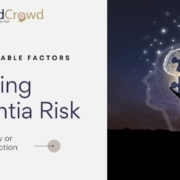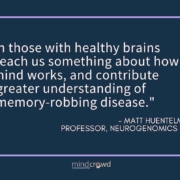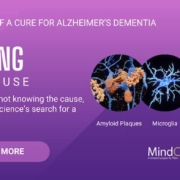Reaction Time as a Measure of Brain Health • MindCrowd Study Findings
How Fast Your Brain Reacts Could Reveal How Healthy It Is.
Reaction time can help measure brain health. Why? Because reaction time depends on central nervous system processing speed. Thus, visual reaction time is a critical factor in higher cognitive functions.
The healthier the brain, the faster its processing speed, memory and thinking skills.
Finding out what impacts reaction time is important. Doing so can help us figure out what is part of healthy aging and what might reveal a diseased brain.
“Our findings have begun to pull back the curtain on the intricate network connecting processing speed and cognition to more accurately describe the comparisons of healthy, versus pathological, brain aging,” said Matt Huentelman, Ph.D., TGen Professor of Neurogenomics, a MindCrowd founder, and the study’s senior author.
The MindCrowd research shows that how fast your brain reacts could show how healthy it is.

What is Visual Reaction Time
Visual reaction time is the time it takes to respond to a visual stimulus. For example, the sudden appearance or change of a picture or color.
If you took the MindCrowd test, your visual reaction time was measured. We anonymized your results together with thousands of others. And these results have helped our scientists further healthy brain research.
Thanks to you, we discovered that reaction times (RTs) not only decline with age but with other factors.
Let’s talk about these factors and what we can do to keep our brains healthy for as long as we live.
MindCrowd Key Study Findings: Size and Diversity Matters
The MindCrowd study has a very large number of participants of all ages and backgrounds. Its size and diversity makes it one of the most important RT studies across the aging spectrum.
Dr. Talboom, Ph.D., a postdoctoral fellow in Dr. Huentelman’s lab and the lead author of the study, suggests that the findings will help develop a sound model of healthy brain aging.
MindCrowd data showed that average reaction time slowed by 7 milliseconds per year. But age is not the only factor that slows down reaction time.
Other findings include:
- men, on average, are 34 milliseconds faster than women;
- the more education one attained, the faster your reaction time;
- younger left-handed people had a shorter reaction time than right-handed ones. But the difference fades between 40 and 60 years of age.
Factors that Affect Visual Reaction Time
One of MindCrowd’s goals is to help better define what is normal brain aging. As well as identify what affects memory and brain performance.
This will help us discover what we need to have the cognitive healthspan match the human lifespan.
Because our goal is to find out how to help you keep your memory and thinking skills optimized throughout your whole life.

It is well known that age affects visual reaction times. Our scientific study has identified other factors besides age that affect reaction time. These include:
- education,
- biological sex,
- smoking,
- dizziness,
- the number of daily prescription medications you take,
- a family history of Alzheimer’s disease,
- being right or left handed.
Age and Reaction Time as a Measure of Brain Health
Age is the main factor known to influence reaction time.
Processing speed limits most aspects of cognition during aging, especially memory. The slower our processing speed, the longer it may take to remember or to figure something out.
The study data showed reaction time performance degraded by an average of 3 to 6 ms per year.
The results showed that both processing speed and memory declined with age.
Shorter visual reaction times and correct word pair association went hand in hand. Each additional word pair correct was associated with shorter visual reaction times.
We observed this relationship from younger to older ages, at 20, 40, 60, and 80 years old.

How Did MindCrowd Measure Reaction Times?
MindCrowd logged participants’ simple visual reaction time (svRT) measured in milliseconds. Participants hit a key whenever a pink ball appeared at random on the computer screen.
The researchers also assessed participants through a word pair memory test.
You can make a difference.
Help us find out how to extend quality of life by keeping our memory + cognitive abilities for life.
Males Have Faster Visual Reaction Times than Females
Men had a shorter visual reaction time than women by an average of 34 ms.
And their increase in processing speed with age was slower than women’s by an average of 0.36ms.
In contrast, our earlier findings show that women score better on verbal memory than men.

More Education equals Faster Brain Processing Speeds
Educational attainment was also a significant factor associated with visual reaction time. We found that more education equals shorter RT or faster brain processing speed.
People with college degrees or in college had shorter reaction times than those who didn’t finish high school. Each had 32 and 15 ms faster processing speeds than those with no high school diploma.
And more education reduced performance loss due to age for both men and women alike.

Left-Handed vs Right-Handed
This was a very interesting finding. Left-handed participants had a 4 ms shorter reaction time that their right-handed counterparts. But this “advantage” faded in individuals 40 to 60 years old.
Thus, left-handedness stops being a predictor after the age of 40.
Be part of the solution. Help scientists understand how to prevent dementia. Take the MindCrowd test today 👉 mindcrowd.org
MindCrowd is a scientific study that gives researchers a set of data baselines about how normal, healthy brains perform at different ages.
MindCrowd cannot diagnose dementia or predict the risk for cognitive decline. By taking this quiz you will help researchers in the future to more properly evaluate Alzheimer’s patients and usher in a new era of precision aging.
Test your brain 👉 mindcrowd.org 🙏
MindCrowd: Do health, medical, and lifestyle factors impact RT?
On health and medical factors impacting visual reaction time, we found that:
- Participants who reported a stroke, had a 20 ms longer reaction time than those who did not.
- Not only did smokers have a 7 ms lengthened visual reaction time, they added 0.57 ms to their RT per year.
- People with diabetes had an 11 ms longer RT than people who did not report this condition.
- Dizziness was associated with a 5 ms longer visual reaction time.
- The number of daily medications taken had an impact on reaction times. The more meds, the slower the visual reaction time.
- A first-degree family history of Alzheimer’s disease didn’t have a strong impact on brain performance. Neither did hypertension.
People should care about their cardiovascular health. stroke and smoking, diabetes, and dizziness were all associated with longer reaction times.
Reaction Time as a Measure of Brain Health: Other Findings
In the MindCrowd analysis, we noticed an interaction between age and education and smoking. Less education and smoking were related to even more slowing of visual reaction time on top of the one related to aging.
Smoking and stroke and amount of education are factors that influence RT slowing as we age.

Many health, medical and lifestyle factors can be changed or managed. Maintaining good cardiovascular health and building cognitive demand or reserve. A healthy diet, exercise and socialization can help keep our brains healthier. Have regular health checkups and maintain healthy habits for a fit body and a fit brain.
Benefits of the Online MindCrowd Scientific Study
Improving Quality of Life & Savings Billions in Healthcare Costs
In Dr. Huentelman’s words: “Many things in our study linked to brain health during aging, like biological sex, are not our choice. But, not smoking is an example of a choice we can make to have a healthier brain during aging.
Reducing cognitive decline due to age or disease or allowing people to stay independent for longer would have many benefits.
These can go from saving billions in healthcare costs to increasing caregivers’ productivity. All the while improving the quality of life for the aging population.
Part of our goal is to enable the cognitive healthspan to better match the human lifespan.
As many more people keep participating in MindCrowd, we will keep seeking the knowledge needed to optimize cognitive performance throughout life.”

Contributing to this study were: City of Hope National Medical Center, Arizona Alzheimer’s Consortium, Norwegian University of Science and Technology, University of Miami Miller School of Medicine and its Evelyn F. McKnight Brain Institute, and the University of Arizona.
The study — Modifiers of Age-Associated Variation in Reaction Time: Two Separate, Large Cohorts Reveal Potential Modifiers of Age-Associated Variation in Visual Reaction Time Performance — was supported by: the UK Biobank, Mike Mueller and the Mueller Family Charitable Trust, the Arizona Department of Health Services through the Arizona Alzheimer’s Consortium, Flinn Foundation, The McKnight Brain Research Foundation, the National Institute on Aging, many anonymous donors, and institutional support from TGen, City of Hope, and the University of Arizona.
FIND OUT MORE ABOUT YOUR BRAIN.
Discover how it compares with others like you in 10 short minutes by playing the free online MindCrowd memory game.
And help scientists find new ways to protect our brains from memory loss as we age.
Stay Tuned for News about Brain Aging and How to Avoid Cognitive Decline.









I appreciate your research findings about brain’s processing speed and age and that it can be used as a measure of brain health. It’s very interesting.